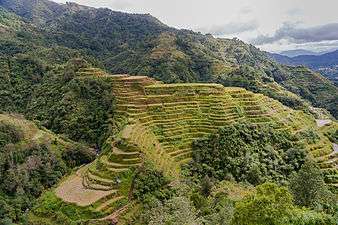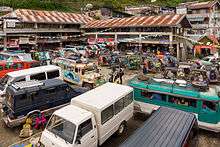Banaue
| Banaue | |
|---|---|
| Municipality | |
 | |
 Map of Ifugao showing the location of Banaue | |
.svg.png) Banaue Location within the Philippines | |
| Coordinates: 16°55′08″N 121°03′32″E / 16.91889°N 121.05889°ECoordinates: 16°55′08″N 121°03′32″E / 16.91889°N 121.05889°E | |
| Country | Philippines |
| Region | Cordillera Administrative Region (CAR) |
| Province | Ifugao |
| District | Lone District |
| Barangays | 18 |
| Government[1] | |
| • Mayor | Jerry U. Dalipog |
| Area[2] | |
| • Total | 191.20 km2 (73.82 sq mi) |
| Population (2010)[3] | |
| • Total | 22,365 |
| • Density | 120/km2 (300/sq mi) |
| Time zone | PST (UTC+8) |
| ZIP code | 3601 |
| Dialing code | 74 |
| Income class | 4th class |
| Website |
www |
Banaue (or alternatively spelled as Banawe) is a fourth class municipality in the province of Ifugao, Philippines. According to the 2010 census, it has a population of 22,365 people.[3] It is widely known as the site of the UNESCO World Heritage Site, the Batad Rice Terraces and Bangaan Rice Terraces.
Barangays
Banaue is politically subdivided into 18 barangays.[2]
- Amganad
- Anaba
- Balawis
- Bangaan
- Batad
- Bocos
- Banao
- Cambulo
- Ducligan
- Gohang
- Kinakin
- Uhaj
- Poblacion
- Poitan
- Pula
- San Fernando
- Tam-an
- View Point
Demographics
| Population census of Banaue | ||
|---|---|---|
| Year | Pop. | ±% p.a. |
| 1990 | 16,943 | — |
| 1995 | 20,514 | +3.65% |
| 2000 | 20,563 | +0.05% |
| 2007 | 21,448 | +0.58% |
| 2010 | 22,365 | +1.54% |
| Source: National Statistics Office[3] | ||
Ifugao Rice Terraces
Sometimes called by locals as the "Eighth Wonder of the World", the Ifugao Rice Terraces begin at the base of the mountain range and extend several thousand feet upwards. Two of the terrace clusters in Banaue, namely Bangaan and Batad, are part of the UNESCO World Heritage inscription. It is said that their length, if put end to end, would encircle half of the globe. Built 2,000 years ago, the rice terraces manifest the engineering skill and ingenuity of the sturdy Ifugaos. They are irrigated by means of mountain streams and springs that have been tapped and channelled into canals that run downhill through the rice terraces.

The rice terraces once stretched north-east to Cagayan and as far south as Quezon. However they are now slowly being abandoned and showing signs of deterioration. A severe 1990 earthquake damaged some of the terraces' irrigation systems, while El Niño triggered droughts that led giant earthworms to erode the terraces' soil. Furthermore, the rice variety most suited to the area's cool climate is not a high-yielding crop; because it takes so long to mature, some Ifugao families have abandoned their land in the rice terraces in favour of land that reaps faster rewards.
An Ifugao Terraces Commission was created in 1994 and was superseded by the Banaue Rice Terraces task force, which was closed in 2002.
UNESCO has listed the Batad Rice Terraces and Bangaan Rice Terraces as a World Heritage Site since 1995, under the designation, Rice Terraces of the Philippine Cordilleras.[4]
All located in the Ifugao region, the Rice Terraces also feature as one of the Globally Important Agricultural Heritage Sites or GIAHS. They are supported by indigenous knowledge management of muyong, a private forest that caps each terrace cluster. The muyong is managed through a collective effort and under traditional tribal practices. The communally managed forestry area on top of the terraces contains about 264 indigenous plant species, mostly endemic to the region. The terraces form unique clusters of microwatersheds and are part of the whole mountain ecology. They serve as a rainwater filtration system and are saturated with irrigation water all year round. A biorhythm technology, in which cultural activities are harmonised with the rhythm of climate and hydrology management, has enabled farmers to grow rice at over 1 000 metres.
Contrary to popular notion, the Banaue Rice Terraces as seen from the viewpoint are not included in the UNESCO inscription, due to the presence of numerous modern structures. However, it is a National Cultural Treasure under the Ifugao Rice Terraces.
The Banaue Rice Terraces were chosen as one of the two green globe destinations of the country by the World Travel and Tour Council. It received an “International Historic Engineering Landmark Award” from the American Society of Civil Engineers. It was also acknowledged by the World Travel and Tour Council as a green globe destination in the Philippines.[5]
The stone walled rice terraces were built by means of early tools and methods in order to maximise the use of land space, They exceed the height of the world’s tallest building if the vertical distance between top and bottom row are measured.[5]
Climate
| Climate data for Banaue, Ifugao | |||||||||||||
|---|---|---|---|---|---|---|---|---|---|---|---|---|---|
| Month | Jan | Feb | Mar | Apr | May | Jun | Jul | Aug | Sep | Oct | Nov | Dec | Year |
| Average high °C (°F) | 24 (75) |
24 (75) |
25 (77) |
26 (79) |
25 (77) |
25 (77) |
24 (75) |
23 (73) |
24 (75) |
24 (75) |
24 (75) |
24 (75) |
24.3 (75.7) |
| Average low °C (°F) | 13 (55) |
13 (55) |
15 (59) |
16 (61) |
16 (61) |
17 (63) |
16 (61) |
16 (61) |
16 (61) |
16 (61) |
15 (59) |
14 (57) |
15.3 (59.5) |
| Average rainfall mm (inches) | 22.8 (0.898) |
26.3 (1.035) |
54.8 (2.157) |
66.1 (2.602) |
313.1 (12.327) |
340.2 (13.394) |
640.7 (25.224) |
748.1 (29.453) |
601.3 (23.673) |
306.4 (12.063) |
131.2 (5.165) |
42.1 (1.657) |
3,293.1 (129.648) |
| Average rainy days | 5 | 5 | 6 | 10 | 21 | 22 | 26 | 26 | 25 | 18 | 11 | 6 | 181 |
| Source: World Weather Online[6] | |||||||||||||
Transport

Banaue can be reached by jeepney, bus, or private car from Baguio City. For bus transportation, Ohayami Trans have a 9:00 PM and Coda lines (former KMS) have 9:30 PM daily trip from Baguio City.
GV Florida Transport Inc./Dangwa Transport Co. Cubao Terminal at EDSA Cor. Kamuning, St.Cubao, Quezon City, departure time from Manila - Banaue is 10:30 PM (Florida, Sampaloc terminal and 11:00 PM (Florida,Cubao terminal ) and from Banaue to Manila is 10:00 PM (Php 530.00 per person for the fare). It also provides daily trips directly to Banaue from Manila with executive deluxe buses, taking 7 to 8 hours.
Ohayami Transport Inc. in front of Rose Bowl, Baguio City. Daily and nightly trips from Baguio City to Banaue and vice versa (via San Jose City)
KMS Trans. Inc beside Rizal Park, Baguio City. Daily and nightly trips from Baguio City to Banaue vice versa (via San Jose City)
See also
References
- ↑ "Official City/Municipal 2013 Election Results". Intramuros, Manila, Philippines: Commission on Elections (COMELEC). 11 September 2013. Retrieved 23 December 2013.
- 1 2 "Province: IFUGAO". PSGC Interactive. Makati City, Philippines: National Statistical Coordination Board. Archived from the original on 1 January 1970. Retrieved 23 December 2013.
- 1 2 3 "Total Population by Province, City, Municipality and Barangay: as of May 1, 2010" (PDF). 2010 Census of Population and Housing. National Statistics Office. Archived from the original (PDF) on 14 November 2013. Retrieved 23 December 2013.
- ↑ Rice Terraces of the Philippine Cordilleras, UNESCO World Heritage Site.
- 1 2 Banaue, e-philippines.
- ↑ "Banaue, Philippines: Average Temperatures and Rainfall". World Weather Online. Retrieved 15 September 2014.
External links
| Wikimedia Commons has media related to Banaue, Ifugao. |
| Wikivoyage has a travel guide for Banaue. |
- Banaue Local Government
- Philippine Standard Geographic Code
- Philippine Census Information
- Local Governance Performance Management System
 |
Barlig, Mountain Province |  | ||
| Hungduan | |
Mayoyao | ||
| ||||
| | ||||
| Hingyon | Lagawe |